|
July 21, 2020
I hope that you and your loved ones are doing well, staying healthy, and looking out for your neighbors and friends.
Today’s news is yet again mixed. We’ve sadly tied our record for the most deaths in a day, at seven. Three are from Clackamas County, and one each from Multnomah, Washington, Umatilla, and Malheur, all counties with a high number of cases. The number of reported new cases is again under 300 today, and the positivity rate has declined to 5.2%.
In today’s newsletter you’ll find information about a new test-site locator that has been created, further details about the ongoing OSU TRACE study of the prevalence of COVID in the state, and links to this week’s legislative budget meetings.
Also, the Governor will be holding a press conference tomorrow morning to provide updates on her COVID-response decisions. If you’d like to watch it live or after the fact, you’ll find information on how to do so below.

TODAY’S CORONAVIRUS AND CORONAVIRUS RESPONSE UPDATE
-
Positive Cases: OHA reports that 270 additional Oregonians have tested positive for COVID. The cumulative total for those testing positive is 14355.
-
Total Tests: The number of tests increased by 5,197. The cumulative total is now 344,479.
-
Ratio: The percentage of positive tests for today is 5.2% of total tests. The national percentage today is 8.3%.
-
Deaths: I’m sorry to have to report 7 additional deaths due to the coronavirus today. Further down in the newsletter, you’ll find information about those we’ve most recently lost. The total number of deaths in Oregon in now 269.
-
Hospitalized: OHA is reporting 19 new COVID hospitalizations. The cumulative number of those who have been hospitalized with COVID is now 1,406.
-
Presumptive Cases: OHA is now including “presumptive COVID-19 cases” in its daily reports, consistent with recently amended guidance from the Centers for Disease Control and Prevention. A presumptive case is someone who does not yet have a positive PCR test result but is showing symptoms and has had close contact with a confirmed case. If they later test positive by PCR, those will be recategorized as confirmed cases. OHA reports an additional 29 presumed positives today. The total number of presumed positives is now 784.
-
Other Hospital Information:
- Patients Currently w COVID-19 Symptoms (who may or may not have received a positive test result yet): 237 (4 more than yesterday). Of those, 155 have already received a positive test back.
- Available ICU Beds: 142 (1 fewer than yesterday).
- Other Available Beds: 718 (57 fewer than yesterday).
- ICU Patients w COVID-19 Symptoms: 64 (6 fewer than yesterday).
- COVID-19 Patients Currently on Ventilators: 34 (same as yesterday).
- Available Ventilators: 776 (3 fewer than yesterday).
-
Dashboards
-
Today’s National Numbers:
-
PPE:
-
Additional Brief Updates:
- The Governor will be holding a press conference tomorrow (Wednesday) at 11 to talk about the latest in Oregon’s coronavirus response, including the second revision of the guidelines for school reopenings. (I know, I told you it would be out today, but it’s being held till tomorrow.) You can watch it here.
- As if Umatilla County hasn’t been hit enough with COVID cases among food processing workers, OHA has just reported an outbreak of 23 COVID-19 cases among employees at the Walmart Distribution Center in Hermiston and their close contacts. OHA reports that it has been investigating a potential outbreak there since the end of June, but the numbers have only now risen to the level of public reporting. They report that “state and county public health officials are working together to address the outbreak and protect the health of workers.”
OHA Unveils New Online Testing Locator
OHA announced today that it has completed work on an online COVID-19 testing site locator (also available in Spanish) to make it easier for people to find COVID testing locations near them. The locator was developed by Castlight, a health navigation platform that connects the information of hundreds of health vendors, benefits resources and plan designs into an online tool. You can locate nearby testing sites by entering your address, county, or zip code..
These are for the most part not drop-in centers. OHA advises you to call the COVID-19 testing site before you go to learn about testing criteria, availability and hours.
Given the increasing lack of testing supplies and processing capacity, OHA is still trying to limit testing to those who have symptoms, in consultation with a health care provider (either your own provider or public health), and keeping in mind the following priority groups (based on high access and vulnerability to the disease):
- Healthcare workers and first responders (EMS, public safety workers)
- Residents, staff, children, and others in non-hospital congregate settings (e.g., residential care facilities, group homes, schools, agricultural workplaces, food processing plants, jails or prisons, shelters)
- Workers who provide direct care or services in multiple group facilities or who provide in-home services (e.g., hospice care workers, physical or occupational therapists, in-home personal care workers)
- Essential front-line service workers who have regular contact with large numbers of people (e.g., those working in grocery, pharmacy, transit, delivery, and other critical infrastructure services)
- People 65 years of age or older
- People with underlying medical conditions, including, but not limited to, hypertension, diabetes, cardiovascular disease, lung disease, obesity, and immunocompromising conditions
- People who identify as Black, African American, Latinx, American Indian/Alaska Native, Asian, Asian American or Pacific Islander
- People who identify as having a disability
- People whose first language is not English
- Pregnant women
- People whose condition requires hospitalization
- People who, within 14 days of their symptom onset, had close contact with a confirmed or presumptive COVID-19 case
What We’re Learning from the TRACE Study
Several legislators and staff received a detailed briefing yesterday from the lead scientists involved in OSU’s COVID TRACE study. TRACE (acronym for Team-based Rapid Assessment of Community-based covid Epidemics) has been underway around the state since May.
It is designed to do random testing for COVID to gauge the prevalence of the disease among people who are not showing symptoms. They’ve done multiple testing in three areas with a substantial Oregon State University presence: Corvallis (home of the main campus), Bend (home of OSU Cascades), and Newport (home of the Hatfield Marine Sciences Center).
Teams of two (generally a health professional and a student, with at least one of them a local) go to randomly-selected homes and ask residents to self-administer a nasal sampling. These are not the swabs that go deep into the nasal passages, so they’re easier to do (but they’ve been normed to be comparable). So far they’ve had very high acceptance rates (between 68% and 80%) and have tested 4,166 in the three communities.
At the same time, a team led by Tyler Radniecki has been conducting analysis of wastewater in the communities, looking for the presence of COVID in fecal material. Infected individuals, whether symptomatic or not, will shed COVID in their fecal material, especially early in the course of the disease. The scientists obviously can’t tell whose material is whose, so they can’t know the exact number of cases. But they can get a good sense of prevalence and the trajectory of the disease from these analyses—so far they’ve seen good correlation between what they’re seeing from the wastewater analyses and what they’re seeing from the actual testing. They are also able to see different concentrations in different towns and even neighborhoods where the wastewater analysis is being done.
Overall, what they’ve seen over the last couple of months (both before and after different stages of reopening) have been relatively low rates of infection in Corvallis and Bend (though it’s suspected that the next round of testing there will show more), and very high rates in Newport (though the most recent testing there is now showing a decline). Their findings have also correlated well with what we’re seeing from actual case counts in those areas.
The TRACE team will be presenting the Legislature with a funding proposal to continue and extend the study statewide. Ideally, they would go in and do testing in 25-49 locations around the state, using wastewater analysis as a way to target those communities that would be good sites for further testing. It of course needs to be done right and won’t be cheap, but if done right it could be useful in helping local and state officials decide when and how to around reopen (and close) schools and other activities. It could be a very powerful use of academic research in service of the public good. (And it may be that we can use federal dollars to help with this work.)
Ways and Means Subcommittees Start Meeting Tomorrow
Last week I shared with you the proposed plan to rebalance the state budget in preparation for the next special session that will likely be held in August. The proposal includes a combination of putting a hold on new programs and positions that haven’t yet gotten underway, making selective cuts to existing programs and positions, and using reserves from the Education Stability Fund.
The various Ways and Means Subcommittees will be meeting in public session this Wednesday, Thursday, and Friday to hear public testimony about the proposal. Here’s the schedule for those meetings. If you click on the links, you’ll see the agendas for each of the subcommittees and can click on “Meeting Materials” to see the detailed proposals for each major budget area. The agenda page will tell you how to sign up to testify orally or via written testimony. You can watch the meeting by clicking on the video icon.
Wednesday, July 22:
Natural Resources: 9 am-12 pm https://olis.oregonlegislature.gov/liz/2019I1/Committees/JWMNR/2020-07-22-09-05/Agenda
General Government: 1-4 pm https://olis.oregonlegislature.gov/liz/2019I1/Committees/JWMGG/2020-07-22-13-00/Agenda
Thursday, July 23:
Education: 9 am-12 pm https://olis.oregonlegislature.gov/liz/2019I1/Committees/JWMED/2020-07-23-09-00/Agenda
Human Services: 1-4 pm https://olis.oregonlegislature.gov/liz/2019I1/Committees/JWMHS/2020-07-23-13-00/Agenda
Friday, July 24:
Public Safety: 9 am-12 pm https://olis.oregonlegislature.gov/liz/2019I1/Committees/JWMPS/2020-07-24-09-00/Agenda
Transportation and Economic Development: 1-4 pm https://olis.oregonlegislature.gov/liz/2019I1/Committees/JWMTR/2020-07-24-13-00/Agenda
Where Are Today’s New Cases?
If we put together the positive test results and new “presumptive” cases reported today, the overall number of new cases is 299. Nearly 2/3 of the state’s new cases are from outside the Portland Tri-County region. Here is the breakdown by county for today:
Baker (2)
Benton (1)
Clackamas (15)
Clatsop (3)
Columbia (1)
Coos (1)
Deschutes (7)
Douglas (3)
Harney (2)
Hood River (4)
Jackson (5)
Jefferson (8)
Josephine (2)
Klamath (1)
Lake (1)
Lane (3)
Lincoln (2)
Malheur (18)
Marion (40)
Morrow (10)
Multnomah (67)
Polk (3)
Umatilla (59)
Union (2)
Wasco (1)
Washington (32)
Yamhill (8)
And the Deaths
Oregon’s 263rd COVID-19 death is an 88-year-old woman in Clackamas County who tested positive on June 10 and died on June 15, in her residence.
Oregon’s 264th COVID-19 death is an 88-year-old woman in Malheur County who tested positive on June 28 and died on July 19.
Oregon’s 265th COVID-19 death is a 52-year-old man in Multnomah County who tested positive on June 24 and died on July 18 at Legacy Emanuel Medical Center.
Oregon’s 266th COVID-19 death is a 59-year-old man in Washington County who tested positive on June 23 and died on July 15, at Providence St. Vincent Medical Center. He did not have underlying conditions.
Oregon’s 267th COVID-19 death is an 88-year-old man in Clackamas County who tested positive on July 7 and died on July 19, at Legacy Good Samaritan Medical Center.
Oregon’s 268th COVID-19 death is an 87-year-old man in Clackamas County who tested positive on June 23 and died on July 20.
Oregon’s 269th COVID-19 death is a 47-year-old man in Umatilla County who tested positive on June 29 and died on July 17 at Providence St. Mary Medical Center in Walla Walla, Washington.
Additional Graphs:
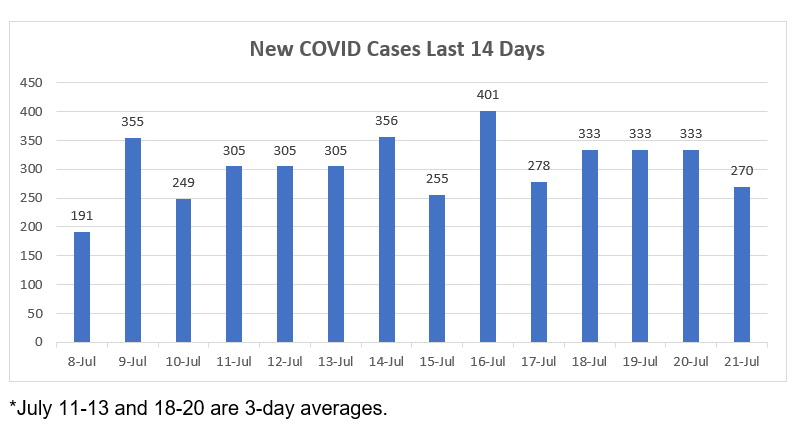
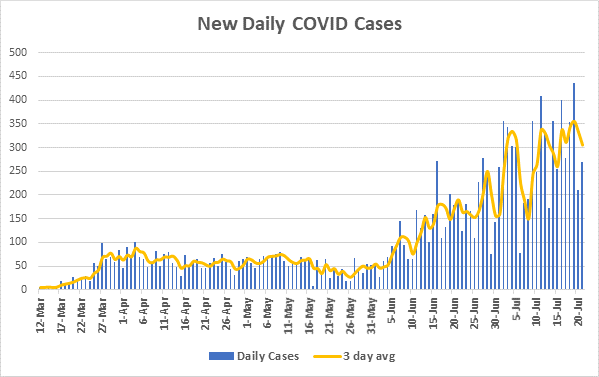
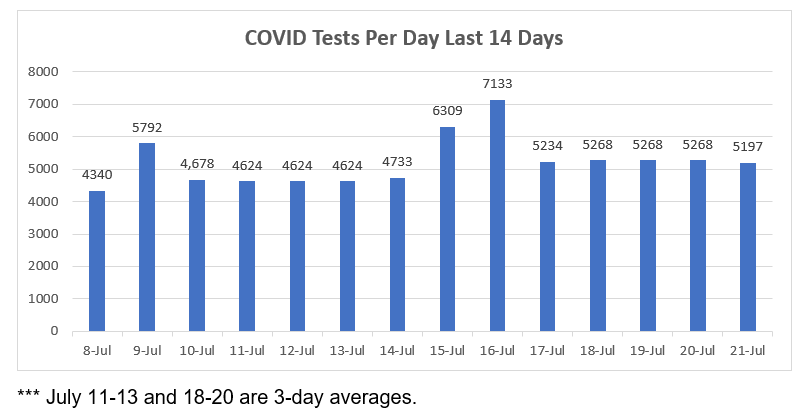
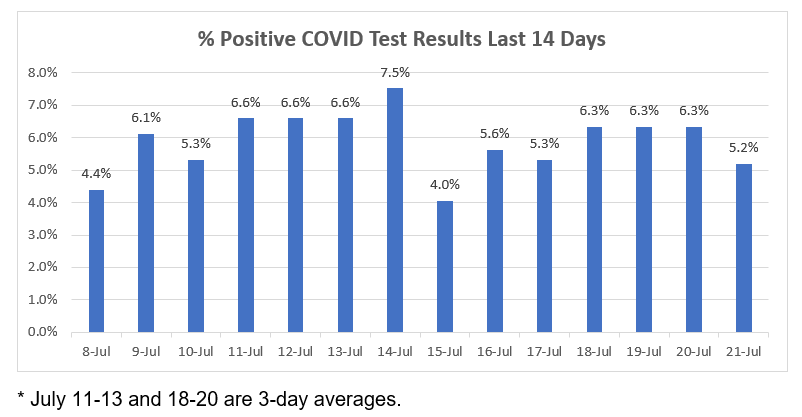
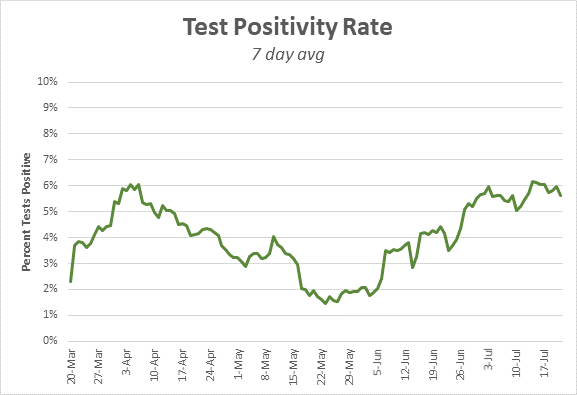
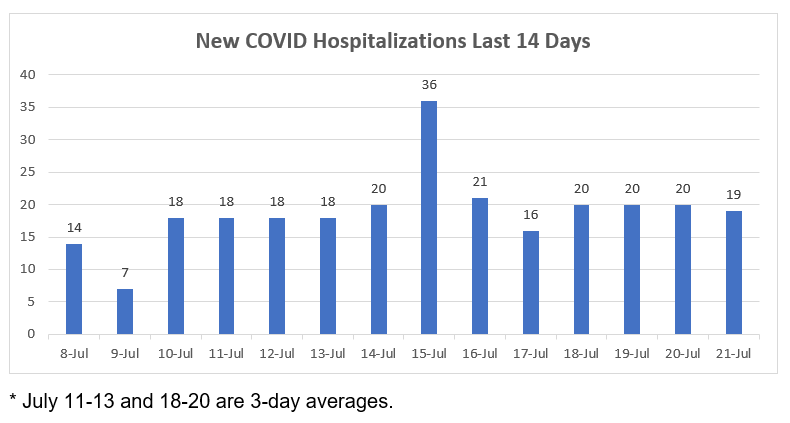
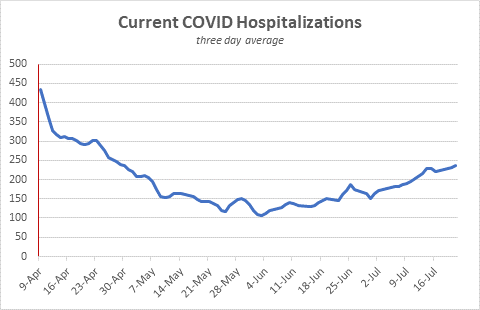
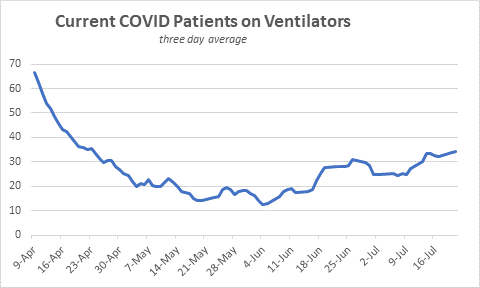
Want to See Past Newsletters?
If there was COVID-related information in a past newsletter that you want to go back to, but find you’ve deleted it, you can always go to my legislative website (www.senatordembrow.com), click on “News and Information,” and you’ll find them all there. Also, if someone forwarded you this newsletter and you’d like to get it directly, you can sign up for it there.


AND FINALLY,
Here again are some resources that you will find useful:
If the above links are not providing you with answers to your questions or directing you to the help that you need, please consider me and my office to be a resource. We’ll do our best to assist you or steer you in the right direction.
Best,
 Senator Michael Dembrow
District 23
email: Sen.MichaelDembrow@oregonlegislature.gov
web: www.senatordembrow.com
phone: 503-986-1723
mail: 900 Court St NE, S-407, Salem, OR, 97301
|